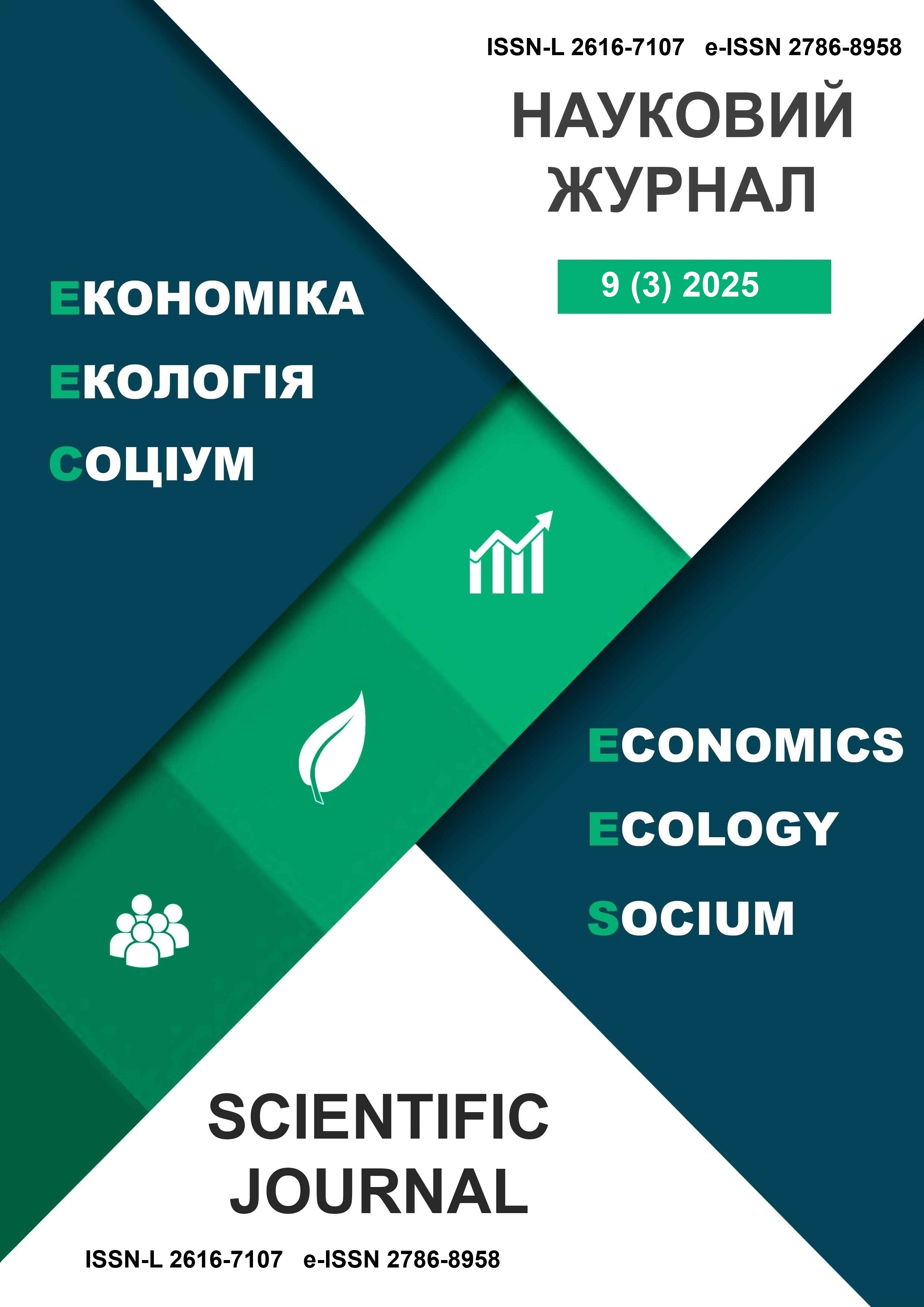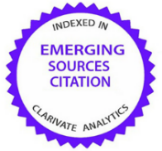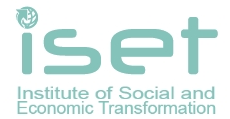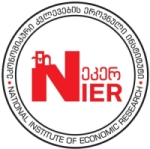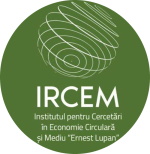Investment Risk Management in Major Stock Exchanges and SME Markets of Emerging Economies
Abstract
Introduction. Small and medium enterprises (SMEs) are crucial in the economy by providing jobs, contributing to GDP, efficiently providing products and services where economies of scale are not needed and creating cash flows. However, SMEs encounter certain obstacles, with financial constraints being the major ones. SME markets have been perceived as another opportunity for SMEs to obtain external financing.
Aim and tasks. This study aims to analyse the interactions between major stock and SME markets in emerging economies, focusing on China, India, and Indonesia.
Results. The diagonal BEKK and DCC-GARCH models analyse the transitions between these stock markets. The study findings offer compelling evidence of dynamic conditional correlations across all markets and illustrate significant volatility spillovers among the SME markets. This correlation is evident both in the short and long periods. The evidence indicates that small- and medium-sized market volatility significantly affects larger markets. The findings reveal a substantial interplay between the major and SME stock markets in emerging economies, including China, India, and Indonesia. According to the diagonal BEKK and the DCC results, investors should not expect significant diversification benefits by including primary and SME market instruments in their portfolios. Investors should closely monitor the co-movements and transitions between these markets to optimise their portfolio diversification strategies.
Conclusions. Creating an environment and conditions that promote the growth of SMEs and improve resilience through specific fiscal alternatives, enhancing access to financing, and upgrading market infrastructure are essential. This study found substantial interplay between major and SME stock markets. Policymakers should be aware that SME market fluctuations influence larger stock exchanges and destabilise macroeconomic conditions, such as economic stability and growth. Therefore, regulatory actions that project the need and operational efficiency of stock market segments should be implemented to prevent adverse effects. For instance, transparency and risk management can stabilise SME stock markets to avoid volatility in larger markets.
Keywords:
SME Stock Market, Emerging Economies, Volatility Spillover, GARCH model.References
Al-Nassar, N. S., & Makram, B. (2022). The COVID-19 Outbreak and Risk–Return Spillovers between Main and SME Stock Markets in the MENA Region. International Journal of Financial Studies, 10(1), 6. https://doi.org/10.3390/ijfs10010006
Anyikwa, I. C., & Phiri, A. (2023). Dynamics of return and volatility spill-over between developed, emerging and African equity markets during the Covid-19 pandemic and Russia–Ukraine war. Studies in Economics and Econometrics, 47(2), 144–168. https://doi.org/10.1080/03796205.2023.2216878
Arakelyan, M. (2024). Current trends and challenges of the development of small and medium-sized enterprises in the RA. Messenger of Armenian state university of economics, 94–110. https://doi.org/10.52174/1829-0280_2024.1-94
Arora, N., & Singh, B. (2020). The long-run performance of SME IPOs in India: empirical evidence from Indian stock market. Journal of Asia Business Studies, 15(1), 88–109. https://doi.org/10.1108/jabs-10-2019-0305
Arouri, M. E. H., Jouini, J., & Nguyen, D. K. (2012). On the impacts of oil price fluctuations on European equity markets: Volatility spillover and hedging effectiveness. Energy Economics, 34(2), 611–617. https://doi.org/10.1016/j.eneco.2011.08.009
Belanes, A., Saâdaoui, F., & Abedin, M. Z. (2024). Potential diversification benefits: A comparative study of Islamic and conventional stock market indexes. Research in International Business and Finance, 67, 102098. https://doi.org/10.1016/j.ribaf.2023.102098
El-Halaby, S. I., Soliman, H. A., & Ahmed, H. M. (2023). The impact of COVID-19 pandemic on financial performance: Comparison between Egyptian SMEs Tamayoz and EGX30 index. Asian Academy of Management Journal, 28(2), 371–419. https://doi.org/10.21315/aamj2023.28.2.13
Engle, R. (2002). Dynamic conditional correlation: A simple class of multivariate generalized autoregressive conditional heteroskedasticity models. Journal of Business & Economic Statistics, 20(3), 339–350.
Engle, R. F., & Kroner, K. F. (1995). Multivariate simultaneous generalized ARCH. Econometric Theory, 11(1), 122–150.
Fiseha, G. G., & Oyelana, A. A. (2015). An assessment of the roles of small and medium enterprises (SMEs) in the local economic development (LED) in South Africa. Journal of Economics, 6(3), 280–290. https://doi.org/10.1080/09765239.2015.11917617
Ghalke, A., Kumar, S., & Rao, S. V. D. N. (2022). SME financing through public equity: review of the Indian SME exchanges. Indian Growth and Development Review, 15(1), 85–97. https://doi.org/10.1108/igdr-10-2021-0138
Harris, R. D., & Pisedtasalasai, A. (2006). Return and volatility spillovers between large and small stocks in the UK. Journal of Business Finance & Accounting, 33(9–10), 1556–1571.
Harwood, A., & Konidaris, T. (2015). SME exchanges in emerging market economies: A stocktaking of development practices. World Bank Group Policy Research Working Paper, 7160. https://openknowledge.worldbank.org/handle/10986/21381
Hasan, A., Ahsan, M. A., & Aslam, A. (2024). Exploring small and medium enterprises access to finance: A bibliometric analysis. Journal of Economic Studies and Financial Research, 5(1), 15–46. https://doi.org/10.46610/jesfr.2024.v05i01.002
Hu, Z., & Li, L. (1998). Responses of the stock market to macroeconomic announcements across economic states. International Monetary Fund.
Huang, Y., Su, W., & Li, X. (2010). Comparison of BEKK GARCH and DCC GARCH models: An empirical study. In Advanced Data Mining and Applications: 6th International Conference, ADMA 2010, Chongqing, China, November 19–21, 2010, Proceedings, Part II 6 (pp. 99–110). Springer Berlin Heidelberg.
Hung, J. C., & Lin, Y. Y. (2013). Information transition effects between large and small capitalization indices in Tokyo Stock Exchange. Journal of Accounting, Finance & Management Strategy, 8(2), 13.
International Monetary Fund. (2016). World economic outlook, October 2016: Subdued demand: Symptoms and remedies. International Monetary Fund.
Jena, S. K., Tiwari, A. K., Dash, A., & Aikins Abakah, E. J. (2021). Volatility Spillover Dynamics between Large-, Mid-, and Small-Cap Stocks in the Time-Frequency Domain: Implications for Portfolio Management. Journal of Risk and Financial Management, 14(11), 531. https://doi.org/10.3390/jrfm14110531
Keskin, H., Ġentürk, C., Sungur, O., & Kġrġġ, H. M. (2010). The importance of SMEs in developing economies. In 2nd International Symposium on Sustainable Development (pp. 183-192).
Koulakiotis, A., Babalos, V., & Papasyriopoulos, N. (2016). Financial crisis, liquidity and dynamic linkages between large and small stocks: Evidence from the Athens Stock Exchange. Journal of International Financial Markets Institutions and Money, 40, 46–62. https://doi.org/10.1016/j.intfin.2015.06.004
Kumar, K. K., & Sahu, B. (2017). Dynamic linkages between macroeconomic factors and Islamic stock indices in a non-Islamic country India. The Journal of Developing Areas, 51(1), 193–205.
Li, X., Ye, Y., Liu, Z., Tao, Y., & Jiang, J. (2024). FinTech and SME’ performance: Evidence from China. Economic Analysis and Policy, 81, 670–682. https://doi.org/10.1016/j.eap.2023.12.026
London Stock Exchange. (2024). London Stock Exchange's market for small and medium size growth companies. https://www.londonstockexchange.com/raise-finance/equity/aim
Mirze, S. K. (2010). İşletme (7th ed.). Literatür Yayıncılık.
Nguyen, T., Chaiechi, T., Eagle, L., & Low, D. (2020a). Return and asymmetric volatility transitions between main stock market and second-tier stock market: The case of Hong Kong. In Economics and Finance Readings: Selected Papers from Asia-Pacific Conference on Economics & Finance, 2019 (pp. 29–49). Springer Singapore.
Nguyen, T., Chaiechi, T., Eagle, L., & Low, D. (2020b). Dynamic transitions between main stock markets and SME markets: Evidence from tropical economies. The Quarterly Review of Economics and Finance, 75, 308–324.
Özkaya, H. (2021). Sticky cost behavior: evidence from small and medium sized enterprises in Turkey. Eurasian Economic Review, 11(2), 349–369. https://doi.org/10.1007/s40821-020-00156-8
Pefindo. (2024). Index Pefindo. https://www.pefindo.com/services/index/pefindo25
Sahoo, S., & Kumar, S. (2022). Does lead-lag relationship exist among large cap, mid cap and small cap segments of Indian capital market? Southeast Asian Journal of Economics, 10(2), 95–119.
Samitas, A., Kenourgios, D., & Konstantopoulos, N. (2006). The small business capital market behavior in Athens Stock Exchange. Small Business Economics, 27, 409–417.
Santia, T. (2020). How many MSMEs in Indonesia? This is the count. Liputan6. https://www.liputan6.com/bisnis/read/4346352/berapa-jumlah-umkm-di-indonesia-ini-hitungannya
Shinozaki, S. (2014). A new regime of SME finance in emerging Asia: Enhancing access to growth capital and policy implications. Journal of International Commerce Economics and Policy, 05(03), 1440010. https://doi.org/10.1142/s1793993314400109
Singh, R. K., Garg, S. K., & Deshmukh, S. G. (2010). The competitiveness of SMEs in a globalized economy: Observations from China and India. Management Research Review, 33(1), 54–65.
SME Chamber of India. (2024). SME sector in India. https://www.smechamberofindia.com/about-msme-in-india.php
Sri Artini, L. G., & Sri Sandhi, N. L. P. (2021). Comparison of SME stock portfolio and manufacturing company performance in the Indonesian, Indian and Chinese stock markets. Journal of Economic and Administrative Sciences, 37(2), 209–237.
StartsupCentrum. (2024). 2023 – Turkey startup ecosystem investment report. https://startupcentrum.com/tr/rapor/2023-turkish-startup-ecosystem-funding-report
Stein, P., Ardic, O. P., & Hommes, M. (2013). Closing the credit gap for formal and informal micro, small, and medium enterprises. International Finance Corporation, World Bank.
Susanty, A., Puspitasari, N. B., & Fachreza, A. (2023). Measuring the performance of SMEs during the pandemic situation using system dynamic. Kybernetes, 52(7), 2538–2567.
Tambunan, T. (2009). Export‐oriented small and medium industry clusters in Indonesia. Journal of Enterprising Communities: People and Places in the Global Economy, 3(1), 25–58.
The World Federation of Exchanges. (2024). Exchanges ESG Factsheets. Retrieved January 30, 2025, from https://www.world-exchanges.org/our-work/statistics
Tien, H. T., & Hung, N. T. (2022). Volatility spillover effects between oil and GCC stock markets: a wavelet-based asymmetric dynamic conditional correlation approach. International Journal of Islamic and Middle Eastern Finance and Management, 15(6), 1127–1149. https://doi.org/10.1108/imefm-07-2020-0370
UK Essays. (2013). Role of SMEs in economic development. https://www.ukessays.com/essays/economics/smes-role-in-national-economies-economics-essay.php?vref=1
World Bank. (2023). Small and medium enterprises (SMEs) finance. https://www.worldbank.org/en/topic/smefinance
Xu, W., Ma, F., Chen, W., & Zhang, B. (2019). Asymmetric volatility spillovers between oil and stock markets: Evidence from China and the United States. Energy Economics, 80, 310–320.
Yadav, N., Singh, A. B., & Tandon, P. (2023). Volatility spillover effects between Indian stock market and global stock markets: A DCC-GARCH model. FIIB Business Review. https://doi.org/10.1177/23197145221141186
Zhang, X. (2021). Coordinated global response key to MSMEs’ post-pandemic economic recovery. World Trade Organization. https://www.wto.org/english/news_e/news21_e/msmes_22oct21_e.htm
Zhong, Y., & Liu, J. (2021). Correlations and volatility spillovers between China and Southeast Asian stock markets. The Quarterly Review of Economics and Finance: Journal of the Midwest Economics Association, 81, 57–69. https://doi.org/10.1016/j.qref.2021.04.001
If the article is accepted for publication in the journal «Economics. Ecology. Socium» the author must sign an agreementon transfer of copyright. The agreement is sent to the postal (original) or e-mail address (scanned copy) of the journal editions.
